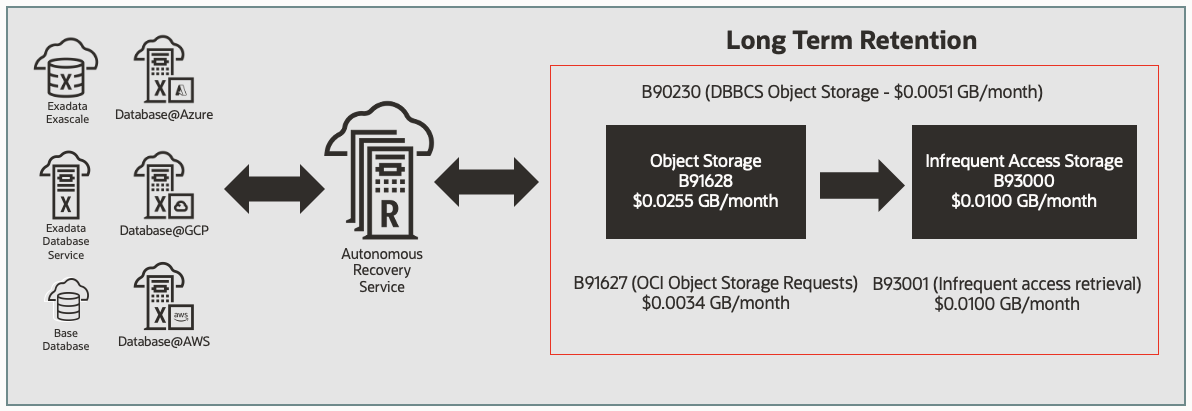Regulatory and internal business rules require many organizations to retain specific, typically monthly, backups for years. This could mean dozens of full database copies over the retention requirement lifetime. The new long-term retention feature in Autonomous Recovery Service meets these requirements by retaining backups for up to 10 years in a cost-effective manner, at half the cost of alternatives. The long-term retention feature is supported for the following database services: Base Database Service, Exadata Database Service on Dedicated Infrastructure and Exadata Database Service on Exascale Infrastructure as well as in Oracle Multicloud with Oracle Database@Azure, Oracle Database@Google Cloud and Oracle Database@AWS.
Key Benefits of Long-term Retention in Autonomous Recovery Service
- Easy, one-click creation of new Long-term Retention (LTR) backups to satisfy regulatory and business requirements
- Cost-saving, automatic movement of LTR backups to more cost-effective storage
- No impact on production applications, by offloading the delivery and management of long-term backups to the Autonomous Recovery Service
To learn more about how long-term retention works, see this blog:
https://blogs.oracle.com/maa/post/recovery-service-ltr
Managing Costs for Long-term Retention Backups
If not managed correctly, keeping data available over many years for regulatory requirements can become extremely costly. Table 1 provides some long-term data retention requirements for various regulations that organizations are required to follow.

To help customers control costs, Autonomous Recovery Service leverages the OCI Object Storage and Infrequent Access Storage tiers. When the long-term retention backup is initially created, it will reside in OCI Object Storage for the first 24 hours and then automatically be moved to the OCI Infrequent Access Storage tier for the remainder of the retention period, as shown in Figure 1. The relevant service SKUs and pricing are also shown.

Autonomous Recovery Service manages all restore requests, and automatically determines backups that are needed, whether they reside on Autonomous Recovery Service, OCI Object Storage, or OCI Infrequent Access Storage tier. Note that customers will incur access retrieval charges when restoring from Infrequent Access Storage backups based on the amount of data retrieved during the month.
SKU Descriptions & Prices
As stated above, long-term retention leverages multiple storage layers. Table 2 lists all the components used for long-term retention and their current pricing:

Usage Example
To demonstrate the storage usage and costs, let’s consider an example using automatic backups for Autonomous Recovery Service and Object Storage, with a backup size of 10TB and a monthly backup retained for 12 months.
When using the Autonomous Recovery Service, these are the details of the charges:
- DBBCS charge is incurred for the entirety of the 12-month retention
- OCI Object Storage is charged for the first 24 hours, then the backup is tiered to Infrequent Access Storage
- Infrequent Access Storage is charged after the first 24 hours and for the rest of the 12-month retention
Now, let’s look at the cost for each of these in Table 3 below.

The total cost of keeping this 10TB backup in LTR for 12 months is $1,817.00
If a restore request of 10TB is made and the backup resides in OCI Infrequent Access Storage, the cost would be $100.00, which is 10,000GB charged at $0.0100 per GB requested.
In comparison, keeping the same backup in OCI Object Storage for 12 months will cost $3,672.00 as shown in table 4 below.

Long-term retention backups with Autonomous Recovery Service is approximately half the cost of OCI Object Storage due to use of Infrequent Access Storage.
Customers using either Autonomous Recovery Service or OCI Object Storage could incur the OCI Object Storage Request fees (B91627) for restore operations, where the first 50,000 requests per month are free.
Metering details and service descriptions are found in “Oracle PaaS and IaaS Universal Credits Service Descriptions” here: https://www.oracle.com/contracts/cloud-services
Conclusion
Autonomous Recovery Service continues to be enhanced so that customers can better manage backup costs for OCI Database Cloud Services. Long-term retention is now available to meet regulatory requirements while offering lower storage costs compared to object storage backups.
In addition, Autonomous Recovery Service offers many unique capabilities not found in Object Storage backups and other solutions in the market, such as:
- Zero data loss recovery
- Fast, low-overhead incremental-forever backups
- Continuous anomaly detection and recovery validation
- Database-integrated insights into your Oracle protection status.
If you don’t currently use Autonomous Recovery Service, consider the advantages of this Oracle-recommended solution and use the checklist below to get started.
Useful Links:
Autonomous Recovery Service:
OCI Cost Estimator:
https://www.oracle.com/cloud/costestimator/#/load&tag=ZRCV
About Oracle Database Autonomous Recovery Service
https://docs.oracle.com/en/cloud/paas/recovery-service/dbrsu/about-recovery-service.html
Blog: Checklist to get started with Autonomous Recovery Service
https://blogs.oracle.com/infrastructure/post/autonomous-recovery-service-checklist
Blog: One-click compliance with Long-term Retention now available in Autonomous Recovery Service
https://blogs.oracle.com/maa/post/recovery-service-ltr
Blog: Object Storage vs Autonomous Recovery Service
https://blogs.oracle.com/maa/post/oss-vs-rcv
Oracle Database Services:
Base Database Documentation:
https://docs.oracle.com/en/cloud/paas/base-database/backup-recover/index.html#GUID-A3F9E6F1-9D67-4E80-B91D-E0BEA74F97BD
Exadata Documentation:
https://docs.oracle.com/en/engineered-systems/exadata-cloud-service/ecscm/ecs-managing-db-backup-and-recovery.html#GUID-0B078728-CCAB-4717-9A7B-A706FE861542

